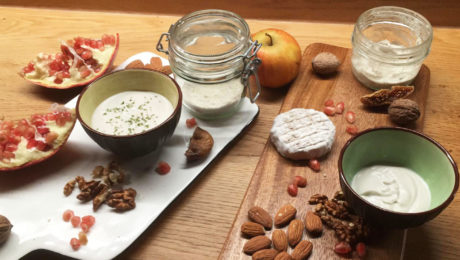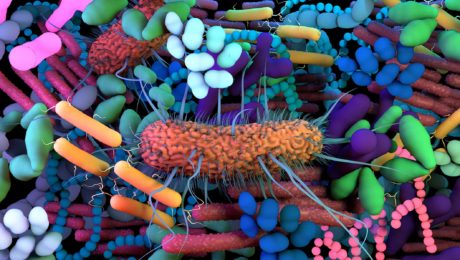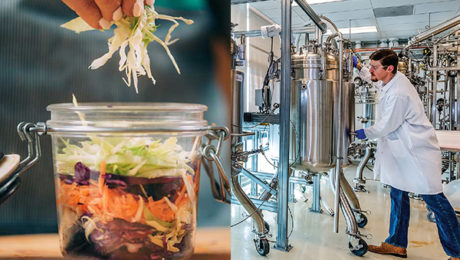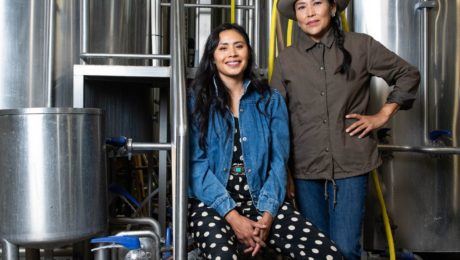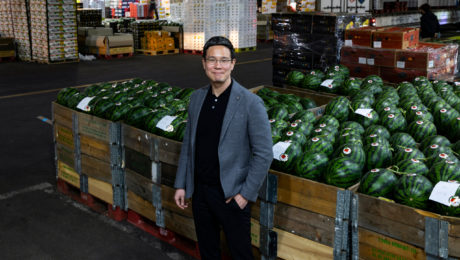French Animal-Free Cheese
A sign that animal free, alternative proteins are gaining more traction – Even Parisians are using microbial fermentation to make dairy-less cheese. Two French startups have raised a combined $14 million to make cheese without cows.
“French cheeses are regarded as some of the best in the world,” reads an article in VegNews. “Two French startups just raised a combined total of $14 million to prove that delicious, complex, melty vegan French cheese can be made in a new way, one that removes cows from the production cycle, improving animal welfare and environmental impact while preserving all of the things people love about cheese.”
Paris-based startup Standing Ovation closed on $12 million this month. The company, founded in 2020, uses microbial fermentation to produce casein proteins that can then be added to vegetable or mineral bases to create replicas of classic French cheeses. Female-led Nutropy raised $2 million in funding for its animal-free casein that can be used in a variety of applications.
“As cheese lovers, we know the importance of cheese in our gastronomic culture and want to offer consumers a wide range of cheeses free of lactose and dietary cholesterol that are produced in an environmentally friendly and sustainable manner,” said Nathalie Rollan, Nutropy CEO.
Read more (VegNews)
- Published in Business
Endangered Fermented Foods
Through selective breeding and domestication of plants and livestock, the world’s food system has lost diversity to an alarming degree. Crops are monocultures and animals are single species. Journalist and author Dan Saladino argues it’s vital to the health of humanity and our planet to save these traditional foods.
“There’s an incredible amount of homogenization taking place in the last century, which has resulted in a huge amount of concentration of power in the food system but also a decline in the amount of biodiversity,” says Saladino, author of Eating to Extinction. “That agricultural and biological diversity is disappearing and it’s taken us thousands, millions of years for plant, animal evolution to get to this point.”
Saladino was a keynote speaker at The Fermentation Association’s conference FERMENTATION 2022, his first in-person talk in the United States since his book was released in February. A journalist with the BBC, Saladino was also an active participant in the event, attending multiple days’ worth of educational sessions. He called the conference “mind expanding.”
“I thought I knew about fermentation, when in fact I know very little,” Saladino said to the crowd in his keynote. “We’ve been bemused by the media reports that fermentation is a fad or fashion. What we know is that the modern food system in the last 150 years is the fad. It’s barely a blip in the context of our evolution as species, and it’s the way we’ve survived as a species over thousands of years.”
Eating to Extinction includes 40 stories of endangered foods and beverages, just touching on a fraction of what is happening around the world. To date, over 5,000 endangered items from 130 different countries have been cataloged by the Slow Food Foundation’s project the Ark of Taste.
During FERMENTATION 2022, Saladino centered his remarks around the endangered fermented foods he chronicled in his book – Salers cheese, skerpikjøt, oca, O-Higu soybeans, lambic beer, pu’erh tea, qvevri wine, perry and wild forest coffee. Here are some of the highlights of his presentation.
Salers cheese (Augergne, Central France)
Fermentation was a survival strategy for many early humans, a fact especially evident in the origins of cheesemaking. In areas like Salers in central France, villagers live in inhospitable mountain areas where it’s difficult to access food. In the spring each year, cheesemakers travel up the mountains with their cattle and live like nomads for months.
“It’s extremely laborious, hard work,” Saladino says, noting there’s only a handful of Salers cheese producers left in France. He marvels at “the ingenuity of taking animals up and out to pasture in places where the energy from the sun and from the soil is creating pastures with grasses with wildflowers and herbs and so on.”
Unlike with modern cheese, no starter cultures are used to make Salers cheese. The microbial activity is provided by the environment – the pasture, the animals and even the leftover lactic acid bacteria in the milk barrels. Because of diversity, the taste is rarely consistent, ranging season to season from mild to aggressive.
“The idea of cheesemaking is a way humans expand and explore these new territories assisted by the crucial characters in this: the microbes,” he adds. “It can be argued that cheese is one of most beautiful ways to capture the landscape of food – the microbial activity in grasses, the interaction of breeds of animals that are adapted to the landscape. It’s creating something unique to that place.”
Skerpikjøt (Faroe Islands)
Skerpikjøt “is a powerful illustration to our relationship with animals, with meat eating,” Saladino says. It is fermented mutton and unique to Denmark’s Faroe Islands. Today’s farmers selectively breed their sheep for ideal wool production, then slaughter the lambs for meat. In the Faroes, “the idea of eating lamb was a relatively new concept.” Sheep are considered vital to the farm as long as they’re still producing wool and milk.
Once a sheep dies or is killed, the mutton carcass is air-dried and fermented in a shed for 9-18 months. The resulting product is “said to be anything between Parmesan and death. It certainly has got a challenging, funky fragrance,” Saldino says.
But it contrasts traditional and modern food practices. Skerpikjøt is meant to be consumed in small quantities, delicate slivers of animal proteins used as a garnish. Contemporary meat is served in large portions and meant to be consumed quickly.
Oca (Andes, Bolivia),
In the Andes – “one of the highest, coldest and toughest places on Earth to live” – humans have relied on wild plants like oca, a tuber. After oca is harvested, it’s taken to the Pelechuco River. Holes are dug on the riverbank, then filled with water, hay and muna (Andean mint). Sacks of oca are placed in the holes, weighted down by stones, and left to ferment for a month. This process is vital as it leaches out acid.
“Through processing, this becomes an amazing food,” Saladino says.
But cities are demanding certain types of potatoes, encouraging remote villagers to plant monocultures of potatoes which are prone to diseases. The farmers end up in debt, buying fertilizers and pesticides to grow potatoes.
“For thousands of years, oca and this fermentation technique and the process to make these hockey pucks of carbohydrates and energy kept them alive in that area,” Saladino says. “It’s a diversity that is fast disappearing from the Andes.”
O-Higu soybeans (Okinawa, Japan)
The modern food industry is threatening the O-Higu soybean, too. It was an ideal soybean species – fast-growing, so it can be harvested before the rainy season and the arrival of insects.
“But by the 20th century, the soy culture pretty much disappeared,” Saladino says.
With World War II came one of America’s biggest military bases to Japan. U.S. leaders dictated what food could be planted on the island. Okinawa was self-sufficient in local soy until American soy was introduced.
Lambic Beer (Belgium)
Saldino explained that, after a spring/summer harvest, Belgian farmers became brewers. They used their leftover wheat to create brews unique to the region.
But by the 1950s and 1960s, larger brewers began buying up the smaller ones. Anheuser-Busch InBev now produces one in four beers drunk around the world.
“There [is] story after story of these distinctive, unique, small breweries disappearing as they are bought up or absorbed into this growing, expanding empire of brewing,” Saladino says. “It’s probably one of the most striking cases of corporate consolidation of a drink and food product.”
Saladino stressed not all is lost. He shared stories of scientists, researchers and local people trying to save endangered foods, collecting seeds, restoring crops and combining traditional and modern-day practices to preserve the world’s rare foods.
“There have been so many fascinating stories of science and research discussed over the last few days at this conference, and I think the existence of The Fermentation Association is exciting because it is bringing together tradition, culture, science, culinary skills, all of these things we know food is,” Saladino added. “Food is economics, politics, geography, anthropology, nutrition. What I’m arguing is that these clues or glimpses into the past for these endangered foods, they’re not just some kind of a food museum or an online catalog. They are the solutions that can help us resolve some of the biggest food challenges we have.”
- Published in Food & Flavor
Harnessing the Power of the Microbiome
A team of nearly three dozen researchers from around the world reviewed case studies on microbiome research in agrifood systems. Their results, published in the journal Frontiers in Microbiology, “showcase the importance of microbiome research in advancing the agrifood system.”
Their 14 success stories include a broad range of topics within agrifood:
- Microbial dynamics in food fermentation
- Using microorganisms as soil fertilizers
- Applications to improve HACCP systems
- Identification of novel probiotics and prebiotics to prevent disease
- Using microbiomes of fermented foods for starter cultures
- Fermenting feed to improve the microbiomes of livestock
- Identifying microbes in fermented meats
- Using microbiota analysis for fermented dairy products
To further microbiome use in food systems, the research points to studies highlighting that fermented foods include many health-promoting metabolites (including studies by TFA Science Advisory Board member Maria Marco, a University of California, Davis, food science professor). But, the researchers stressed: “How certain microorganisms drive food fermentation, are transferred across the food production chain, persist in the final product and, potentially, colonize the human gut is poorly understood.” Researchers conclude that more work is needed to understand how the probiotics and metabolites in fermented foods could be used to treat diseases.
“Agrifood companies recognize the potential in understanding the microbiome and translating this knowledge into products,” the study continues. The food industry, the study notes, is “further preparing to develop personalized diets and specific foods for particular target groups in order to prevent or treat certain chronic conditions.”
“The microbiomes of soil, plants and animals are pivotal for ensuring human and environmental health. Research and innovation on microbiomes in the agrifood system are constantly advancing, and a better understanding of these microbiomes will be a key factor in producing highly nutritious, affordable, safe and sustainable food.”
Read more (Frontiers in Microbiology)
Will Fermentation Connect Gastronomy and Biotech?
Fermentation is motivating scientists to listen to gastronomers, a rare occurrence in the field of science.
“There’s going to be a huge exchange in this two-way road that we’re living in. Innovation in flavor coming from gastronomy and innovation coming from a high-level biotechnology, they are going to be harmonious,” says Jason White, director of the fermentation lab at Noma in Copenhagen. “We’re going to be able to create this infrastructure and community of people who have the same goal, and the same goal is going to be the wellness of our planet.”
White spoke at the 2nd international Food Innovation Conference. This annual gathering of industry experts is produced by the Gottlieb Duttweiler Institute (GDI), Switzerland’s oldest independent think tank, which researches the future of food, retail and health.
The conference focused on the future of fermented alternative proteins. Or, as GDI puts it: “how innovation can solve the carnivore conundrum.” Speakers included the founders of numerous precision fermentation companies, such as SuperBrewed Food, Bosque Foods, Melt&Marble and WNWN Food Labs.
“We do the same thing, we just have different outputs”
Fermentation for alternative proteins is a divisive topic among traditional fermenters. Many say it’s lab-created fake food. Advocates, though, argue precision fermentation using DNA from mammals (as with Impossible Foods’ heme protein burger) and biomass fermentation of fast-growing, naturally-occurring organisms(e.g., Nature’s Fynd fungi protein) are reducing the risk of a global food crisis. Meat consumption is increasing, but animal meat is environmentally inefficient to raise. The significant amounts of agricultural land, fertilizer, pesticide and hormones needed to raise animals for meat protein release harmful carbon emissions.
The chefs on GDI’s “Fermentation: A World Within Gastronomy” panel spoke favorably of using fermentation for alt foods. White was joined by Ezio Bertorelli, co-founder of fermentation shop Meta Copenhagen, and Sirkka Hammer, founder of food manufacturer Wiener Miso in Austria.
“I think that it’s important for us not to steer too far away from the origins of fermentation,” White notes. But, “whether you have this bioreactor filled with whatever working inside of a laboratory with a team of scientists, we are still creating something that comes from microorganisms and from organisms. And so we do the same thing, we just have different outputs, different audiences.”
Precision fermentation technology is rooted in traditional fermentation, he notes. You need to understand the abilities of microbes and composition of ingredients for a successful precision fermentation.
“Inside of these laboratories and restaurants, there’s so many things that are being discovered that stop at the guest experience,” White says of fermentation. Today, as fermentation continues a revitalization as a kitchen craft, it’s utilized by more people rather than just chefs and scientists.
DIscovering Fermentation
Hammer highlighted the boom in home fermentation, with people creating the bold flavors of fermented foods and beverages on their own countertops.
“There’s a certain magic in fermentation. That’s why you’re gripped with it,” she says. “People are bringing a little bit of that magic, uncontrollable magic maybe [into their homes].”
At Wiener Miso, Hammer launched the company’s umami-driven ferments after living in Asia for more than a decade. The spices, pastes and sauces she makes are based on traditional Japanese ferments.
“Fermenting gives you in gastronomy next level or an add-on of flavors and textures,” she says. “Fermentation really changes the texture in a different way than if you cook it or freeze it. It gives it new dimensions.”
Flavor is what introduced Bertorelli to fermentation, too. His background is in professional cooking – he is the former executive chef of La Petite Table in Paris – but he was always experimenting with miso and sauerkraut in his home kitchen.
Even today, his fermentation experiments “go terribly wrong most of the time,” says Bertorelli. Only about 5% are successes, “that’s what makes it exciting.”
“Fermentation really changed my life because it showed me most of the dishes I was passionate about, the origin of the flavor, was the fermented part,” he says. “Flavor is universal… If you have that mind-blowing moment, it can reconnect you with things that are inside all of us, like our ancestors have been eating these foods since thousands of years ago and it’s sort of like going back in time while still being here.”
- Published in Food & Flavor
Naked Wine
Olfactory properties are central to the wine drinking experience. But a chemical reaction known as light strike can ruin the rich aroma. When wine is exposed to ultraviolet or high frequency visible light, its smell can resemble marmalade. Sauerkraut or even wet dog.
This is why wine is stored and aged in dark bottles – the color glass is crucial to producing a great wine.
“Every technician knows about it,” says Fulvio Mattivi, a food chemist at the Edmund Mach Foundation in Italy. “But then the final decision as to what goes on the market is up to the head of marketing.”
Mattivi and collaborators recently published a paper in the Proceedings of the National Academy of Sciences detailing how bottle color affects light strike in wine on grocery store shelves.
Clear bottles made of a refractive material called flint glass are often used to sell white wine and rosé, to show off the fermented beverage’s color. The new research shows that just a week on supermarket shelves in clear bottles can produce smelly compounds. “With exposure, you can have a very bad wine,” Mattivi said. This chemical origin of light strike, including the speed and conditions, has been unknown until Mattivi’s study. In his team’s research, more than 1,000 wine bottles in different grocery store conditions were studied.
Despite consumer preferences for clear bottles, Mattivi gives a hard “no.” He compares it to the folk tale, “The Emperor’s New Clothes.” In the Hans Christian Andersen story, the emperor is conned by swindlers into believing the new clothes they bring him are beautiful – but, in reality, there are no clothes and the emperor is naked.
Mattivi said: “Wine in clear bottles is naked.”
Read more (New York Times)
What Is or Isn’t a Health Claim?
What exactly constitutes a health claim on a food label? It’s a contentious topic that can be a source of problems and expenses for the unwitting producer.
“We want to communicate accurately and effectively to consumers in a way that’s truthful and not misleading. There needs to be a body of evidence that supports health claims,” said Josephine Wee, PhD, an assistant professor of food science at Penn State (and member of TFA’s Science Advisors). “The bottom line: health claims are complicated.”
Wee unpacked what is and isn’t a health claim during the FERMENTATION 2021 conference. Similar topics into the regulation of fermented foods will be addressed at TFA’s August conference, FERMENTATION 2022.
Wee questioned: does the fermentation community require health claims on certain fermented foods? Today, terms like gut health, probiotics and improved immunity dominate the language of fermented foods. But words and definitions matter, Wee stressed.
Defining Health Claims
When putting health claims on a food label, website or marketing material, information must be truthful and transparent. Remember:
– The FDA has approved only 12 health claims. In the U.S., food labels can legally only include health claims that meet FDA requirements. There must be “significant scientific agreement among qualified experts that these claims are factual and truthful,” Wee said. FDA approval is based on the amount of publicly available, scientific evidence from reputable studies.
– A health claim is not a nutrient claim. Food producers cannot link the effect of a nutrient or food to a disease or health condition (other than in the rare case that there is supporting scientific evidence). Nutrient claims are defined by the FDA to “describe the level of a nutrient in the product, using terms such as free, high, and low, or they compare the level of a nutrient in a food to that of another food, using terms such as more, reduced, and lite.”
– A health benefit cannot be used interchangeably with a health claim. A health claim must pass a two-part test: first, contain the characterization of the type of food/food component and, second, state its relationship to a disease. For example: “A good source of calcium and vitamin D. Reduces risk of osteoporosis.”
“The reason for these standards is that it provides a high level of confidence to validate the substance and disease relationship,” Wee said.
What is Not a Health Claim?
Wee said producers must be careful not to mislead consumers with an inaccurate health claim.
She shared the International Scientific Association for Probiotics and Prebiotics (ISAPP) consensus statement on fermented foods. In it, the authors write: “Although consumers have become increasingly interested in fermented foods, it is unfortunate that, in our opinion, much information available on fermented foods in popular press magazines, websites and social media is exaggerated or inaccurate.”
Here are four health-related claims that are not health claims.
1. Description of well-being from consumption of a food. These claims do not mention a disease or disease-related condition. For example, “Multivitamins contribute to general good health.”
2. Structure-function claims. A structure-function claim describes the role of an ingredient in affecting or maintaining normal structure or function in humans. “There is this presence of this food and food ingredient, but it doesn’t really talk about disease,” Wee explained. For example, “Calcium builds strong bones.”
3. Dietary guidance. A dietary label addresses the role of good health in general dietary patterns. For example, “Five servings of fruits and vegetables a day are recommended for good health.”
4. Nutrient content claim. These characterize the level of nutrients in food. For example, “Good source of fiber.”
“These four health-related claims are sometimes mistaken for health claims,” Wee said, “but they’re actually not health claims by the definition of regulatory agencies such as the FDA.”
Where Can Producers Get Into Trouble?
Securing FDA approval for a new health claim can be arduous. Under the Nutrition Labeling Education Act of 1990 (NLEA), a company can petition the FDA to consider a new health claim. But the process is typically lengthy (240-540 days) and costly.
Often, it is a competitor that challenges a producer’s health claim.In 2010, Dannon was ordered to pay $45 million in a class-action lawsuit brought against them by Activia yogurt. Dannon’s ads claimed their yogurt was clinically and scientifically proven to regulate digestion and boost immune systems, but were deemed to be false advertising.
In the past few years, kombucha brands have been particularly vigilant in monitoring health claims in their industry. Tortilla Factory (parent of Kombucha Dog) sued Trader Joe’s, Better Booch, Makana Beverages and Rowdy Mermaid Kombucha for supposedly violating the law by exceeding the 0.5% abv threshold.
“I think as fermented foods become more mainstream…over time consumers will become more educated and understand what these labels mean,” Wee noted.
- Published in Business
Sriracha Shortage
A failed spring chile harvest has left sriracha brands in the lurch. Sriracha – a fermented condiment made with peppers, vinegars, salt, sugar and garlic – can’t be made without the iconic red jalapeño chiles.
Huy Fong Foods, based in Irwindale, Calif., produces one of the most popular sriracha brands. They typically use 100 million pounds of chiles a year to make sriracha, chili garlic sauce and sambal oelek. But drought in Mexico has caused an “unprecedented shortage” and left store shelves consistently empty of the famous sriracha brand.
The chile shortage is hurting other companies, too. Though Mother-in-Law’s Kimchi uses the chiles in their products, they haven’t felt the crunch so far. “It hasn’t trickled down to a smaller supplier like me yet, but I think it just means that it’s coming,” said Lauryn Chun, founder.
Read more (The New York Times)
- Published in Business
Championing Indigenous Brewers
The headline says it all: “The Country’s First Native American Woman-Owned Brewery in the U.S. Doesn’t Want to Be Its Last.”
Co-founders Shyla Sheppard (who has heritage from the Three Affiliated Tribes – Mandan, Hidatsa and Arikara – of North Dakota) and her business partner and wife, Dr. Missy Begay (Diné heritage) founded Bow & Arrow Brewing Co. in 2016. The brewery has become known for wild and sour beers made with cultivated yeast. They forage for neomexicanus hops, a species found in New Mexico. Local and indigenious ingredients – like blue corn, sumac, prickly pear and juniper – are used in a new line of hard seltzers.
Bow & Arrow began a unique initiative on October 11, 2021, Indigenous Peoples’ Day. The brewery launched Native Land. They provided an IPA recipe to breweries across the U.S. to create a beer for a common mission: “to acknowledge the contributions and history of Native American people in the United States.” Participating breweries were given a can design template, which included space to acknowledge the tribal land where the brewery is located.
The campaign was so popular – 53 breweries in 24 states and one Canadian province brewed Native Land beer – that they extended the deadline for the project to September 2022. The beers are “vehicles for activism,” with a portion of proceeds going to a Native American-operated nonprofit of the brewer’s choice.
“We’re reclaiming our history and narrative. I think the contributions that Native people have had to agriculture have been erased or dismissed. It’s important to share that story to non-Native people, but also to other Native folks,” she says. “I think fostering that appreciation and connection to our history brings about healthier Native communities.”
Bow & Arrow is one of only a small number of Native-owned breweries in the U.S. – but Sheppard and Begay hope that will change and, one day, there will be more. Sheppard adds: “Having done what we’ve done — in what I hope is a respectful way of incorporating our culture and background — I think it’s inspiring other brewers.”
Read more (Eater)
- Published in Business, Food & Flavor
“Fermentation…a form of magic”
“Fermentation is hope for trans folks. If people can conceptualize cucumbers becoming pickles, then they can grasp a trans person’s name change. If the possibility of Camembert, Parmesan, and ricotta exist within milk, then think of all the possible genders to choose from!” reads an article in Bon Appetit.
The magazine published an article by transgender cheesemaker-turned-journlaist H. Conley who, while immersed in the world of cheesemaking and the fermentation of milk into cheese, realized they were trans. The article’s accompanying illustration (pictured) by artist Jasjyot Singh Hans is called “Trans-Fermentation.”
Conley writes: “I didn’t see trans fermenters as a pattern until June Henry Hyde, a trans 18-year-old from Kansas, told me her plans to start a pickling business with her nonbinary partner. She showed me the self-administered tattoos on her forearm: a pickled pepper jar next to a star-topped wand.”
“I consider fermentation to be a form of magic,” she told me. For her, transition is magic as well. It takes magic to manifest desired realities. “But there’s this other layer of people who are really averse to fermented foods, like ‘It’s different, it’s undergone this transformation that’s made it less desirable,’” she added. The otherworldly SCOBY in kombucha, the stinging fragrance of kimchi, the very concept of eating mold makes some resistant to giving fermented foods a chance. “It’s seen as an acquired taste in some cases, which resonates with me a lot as a trans person.”
Read more (Bon Appetit)
- Published in Food & Flavor
Trying to Transform the Global Food Trade
The worldwide fresh produce market has long been plagued by mistrust. The industry lacks transparency, a major issue when dealing with perishable goods. The window for transactions is small. There’s no official network, so sellers have a variety of customers, and buyers use many different suppliers.
Enter Tridge (stands for Transaction Bridge), a Korean startup working directly with farmers and grocery stores. Tridge tracks the real-time price, quality and volume of produce. Tridge aims to be a transparent middleman, quickly connecting buyers and sellers when there’s a supply chain interruption.
Hoshik Shin, founder and chief executive of Tridge, says it is a one-stop shop. Farmers can use the data to see which products are more popular, and buyers can check for prices and availability and suppliers can diversify their sales channels.
“Mr. Shin’s ambition is to aggregate that data into a massive, moving, real-time image of fresh produce on the planet,” the article reads. “Anyone can subscribe to Tridge’s intelligence platform and watch the world grow, harvest, pack and ship everything from Indonesian mangosteens to American lemons.”
Read more (The New York Times)
- Published in Business

